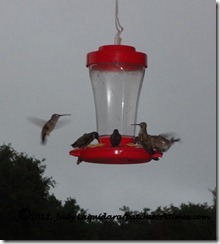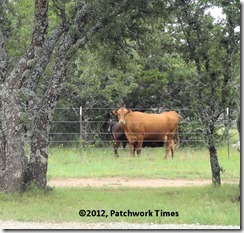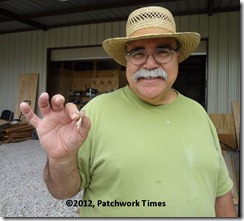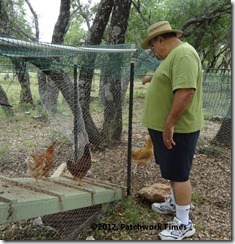Vince and I were sitting out on stumps yesterday evening contemplating the important things in life and where we’re headed. We laugh at ourselves because we’re so different from what we used to be and if someone had told either of us 20 or 30 years ago that we’d be doing what we’re doing now and loving it, we would have had them committed.
Instead of heading out to eat breakfast at a restaurant, which is what we used to do on Saturday mornings, and then going shopping, this morning we had omelettes from yard eggs (not from my chickens yet), bacon, toast from homemade bread, kiwi and cantaloupe.
Then I refilled and hung the hummingbird feeders.
I can’t get over how many of them we have and much nicer they are to each other than our previous hummingbirds. We’ve never had them let other hummers come around while they’re feeding but there’s often 6 or 8 birds feeding off one feeder at the same time. Normally I bring the three feeders in at night, wash them, then scrub my kitchen sink to get all the “bird” off if, let them dry overnight and fill them and put them back out in the morning. We had four feeders but one fell and broke. I mix 2 cups sugar with 8 cups water every morning . . which is one part sugar/four parts water and I add no coloring to it.
While outside looking at Vince’s progress on the new coop, I heard the cows mooing. I tried to pretend I didn’t hear them because I didn’t want to go in and scrub cow slobber off my arms but then I saw it was Miss Red mooing for me.
I like her so much. She’s definitely the lowest cow on the totem pole out there. I think it has to do with having no horns! She’s so sweet and the other cows try to butt her out of the way so I make sure she gets special attention. She doesn’t look like she’s not getting enough to eat . . after all, she’s got about 300 acres with plenty of grass right now. Thank goodness for our recent rains! So, I had to go get treats for the cows. I thought I was going to get lucky and have only Miss Red to feed but then I looked and there the rest of them were . . waiting.
I think they’re sending Miss Red out as a decoy because they know I can’t say no to her. We still can’t get the bull to eat out of our hand but he will come to within inches of our hand but he just won’t reach out and get the treat from our hand.
Vince is working outside and he keeps finding grasshoppers. There are zillions of them out here so he catches them as he finds them (no wonder the coop isn’t finished yet) and gives them to the chickens. They hear his voice and they come running but the first one out the door every time is Big Bertha. Throwing one grasshopper to 14 chickens almost always leads to a whole lot of commotion in the chicken yard.
Just like I try to give the biggest and the most treats to Miss Red, Vince tries to give Bertha as much as he can. On the run is one of the darker red Production Red chickens. They’re small but they’re pretty fierce competitors for the grasshoppers and they get their share. Behind her is one of the Golden Comets which I think is another name for the same chickens we had in Missouri . . the chickens I loved so much! These will all let me pet them now. About half of the Production Reds will let me pet them and Big Bertha . . no way! She wants nothing at all to do with me.
For those who know chickens, do you think Bertha is a Buff Orpington? She’s a lot bigger than my other chickens and has real white legs (like me) where all the others have yellow legs. Not sure the color of the legs makes a difference but . . that’s what she has. The grasshopper jumped right out of Bertha’s grasp and hopped through the fence. See her staring at it? Vince grabbed it back for her but I think in the end, one of the dark red chickens ended up with it.
So, what’s important to us these days? Catching grasshoppers!







Michelle says
Bertha does look like the Buff Orpingtons a friend of mine had…
vickie van dyken says
That sharing book thing pales in comparison to Vince being a good provider of hoppers !!! Love it 🙂
Vickie in WA whose yard is not full of chickens…but there is about 8 Semi-Trucks out there right now….Mostly Peterbilts, a couple of Freightliners, oh and the Harley contingent just arrived 🙂
Kate says
Just curious, why dont you let all the chickens out to clean up the grasshoppers? Obviously you would need to keep an eye out but many of the other farm blogs I read let them all out in the morning and in at night. Just wondering…
Judy L. says
Way too many hawks out here. We’d probably lose them all within a week.
Venessa says
Hi, just wondering if you Judy or any of your followers know if there is a ‘cure’ for chickens who peck eachother’s ‘backsides’ so much that they have just featherless red backsides? We were out at a local farm the other day and the chicken owner said she’s tried everything, but I am willing to share any cures/solutions anyone might suggest. Thanks in advance.
Sally H says
I’m not sure which area, exactly, you mean by “backsides,” but here are my thoughts based on caring for 30+ member flocks for the last 10 years:
Usually the birds that are missing feathers on their backs are hens that are that favorite of an overenthusiastic rooster. He pulls the feathers off when he mounts her to mate. There is a “saddle” that is made for hens to help with this problem (google “chicken saddle”). I’ve also found that a week or two of isolation that provides a chance to grow those feathers back can make a large problem small again. Chicken’s recuperative powers are amazing — I had a hen whose back was cut so deep I could see bone recover completely after three weeks by herself.
Chickens will also sometimes peck each other around their vents (anus in mammals.) This is more common when they are younger. Often adding more protein to the diet (sunflower seeds are an easy source) will alleviate the problem, although if it goes on long enough it becomes habit. Once habit forms, the only solution is to remove those who are most aggressive towards others.
If the birds are pulling out their own feathers the problem may be lice (the chicken version.) Dusting the birds with an insecticide like Sevin, allowing them to dust bathe in wood ashes, and painting their roosts with oil (or replacing the roosts with cedar,) all help control the problem.
Hope that helps. The motto in our house is “when in doubt, buy a book.” I can recommend The Chicken Health Handbook by Gail Damerow.